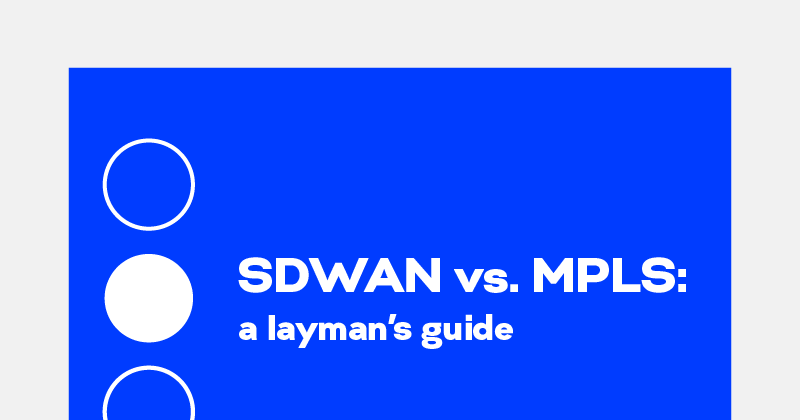SDWAN vs. MPLS: A Layman’s Guide

In previous blog posts in this series about SDWAN, we’ve covered how SDWAN can help unlock additional capabilities around cybersecurity and decoded the omnipresent alphabet soup.
SDWAN vs MPLS
Today, we will step back and compare a long-standing technology—MPLS (Multi-Protocol Label Switching)—with the relative newcomer SDWAN (Software Defined Wide Area Networking) and discuss how they aim to solve the problem of multi-site network connectivity.
This post is intended for IT decision-makers and influencers who are challenged to provide reliable, secure connectivity for their organizations. The purpose of the comparison is purely focused on contextualizing business outcomes.
The technical folks in the room will note that MPLS operates at Layer “2.5”, whereas SDWAN operates at Layer 4-7. Yes, that means technically you can run SDWAN on top of MPLS – but hopefully, this will show why that may not make sense!
What is MPLS?
MPLS is a switching mechanism that uses labels instead of network addresses to route traffic optimally via the shortest pathways. The label configuration of MPLS is static, meaning any changes require reconfiguration.
MPLS was originally developed to help optimize the flow of Internet traffic back in the late 90s and has been broadly used by enterprises ever since.
MPLS uses specialized, typically ISP owned routers which require heavy involvement of network engineers to setup, configure, and change. MPLS typically operates over private links, meaning reliability is usually quite good and wrapped with an SLA. The result is that upfront investment (represented in terms of time, dollars, or both) is usually higher with MPLS, and ongoing costs vary significantly from provider to provider since they typically own the equipment and underlying cost structure.
Still, MPLS has historically been used because it is innately able to accurately route data packets and layer on other Quality of Service guarantees.
What is SDWAN?
SDWAN is a method of connecting networks at the software layer rather than via hardware.
SDWAN was first developed around 2014 and has seen considerable engineering development in the last ~5 years, largely driven by Gartners’ creation of SASE, which builds security features on top of SDWAN core services.
SDWAN builds encrypted tunnels to securely send traffic across regular Internet links, meaning that end customers may purchase commodity Internet connectivity to facilitate “private” network access, which comes at a greatly lower price point with more options. Because of SDWAN’s inherent flexibility, it is optimal for hybrid or multi-cloud environments or for organizations that are constantly changing, expanding, or acquiring.
An Analogy
A go-to analogy for SDWAN vs. MPLS is comparing Uber (SDWAN) to the subway (MPLS). Both subways and Uber transport people from point A to B, although the way in which they do it is quite different.
Subways require significant upfront time, money, and effort to build, and extending the subway means acquiring new land (private circuits), capital to build (budget dollars), construction (network engineering), and time (your competitive advantage). An advantage to subway systems, just like MPLS, is that because they operate over dedicated infrastructure, timing is nearly a guarantee. But, if the subway fails at any point, movement halts.
In contrast, Uber operates on existing public roadways, using software that operates in the cloud. Uber drivers can use the public road ways to go where they want and can take different paths depending on certain conditions. If a roadway is closed or congested, Uber suggests an alternative route. Sometimes, however, the roadway is obstructed, or a traffic jam happens, and your ride takes longer than expected. Flying cars may someday circumvent that issue – luckily, we’ve already figured that out for SDWAN!
Conclusion SDWAN vs MPLS
While we believe that SDWAN represents the next generation of multi-site networking – enabling fast and secure hybrid cloud environments, US Signal offers both SDWAN and MPLS solutions with an expert staff to help guide your decision and support experience.
SDWAN has overcome many of MPLS’s old advantages in its ability to achieve high uptime (redundant cloud infrastructure, utilization of multiple commodity Internet links), Quality of Service, and an aggressive SLA.
SDWAN is ideal if your organization looks to optimize WAN Opex and Capex, provide maximum network reach (into places like public clouds or SaaS), and enhance WAN connectivity (run on anything). Plus, with insights into your network traffic, our Cato-powered solution can provide network security that goes beyond what is possible with traditional technologies.

Sources:
https://www.techtarget.com/searchnetworking/definition/Multiprotocol-Label-Switching-MPLS



